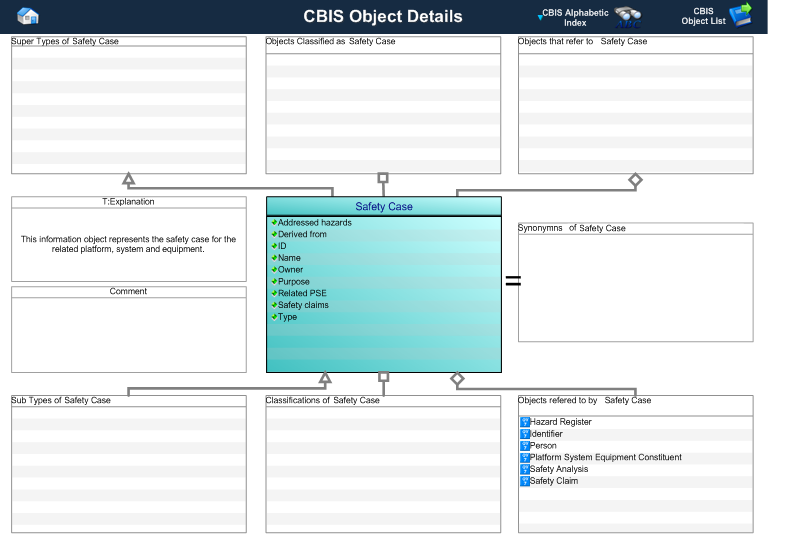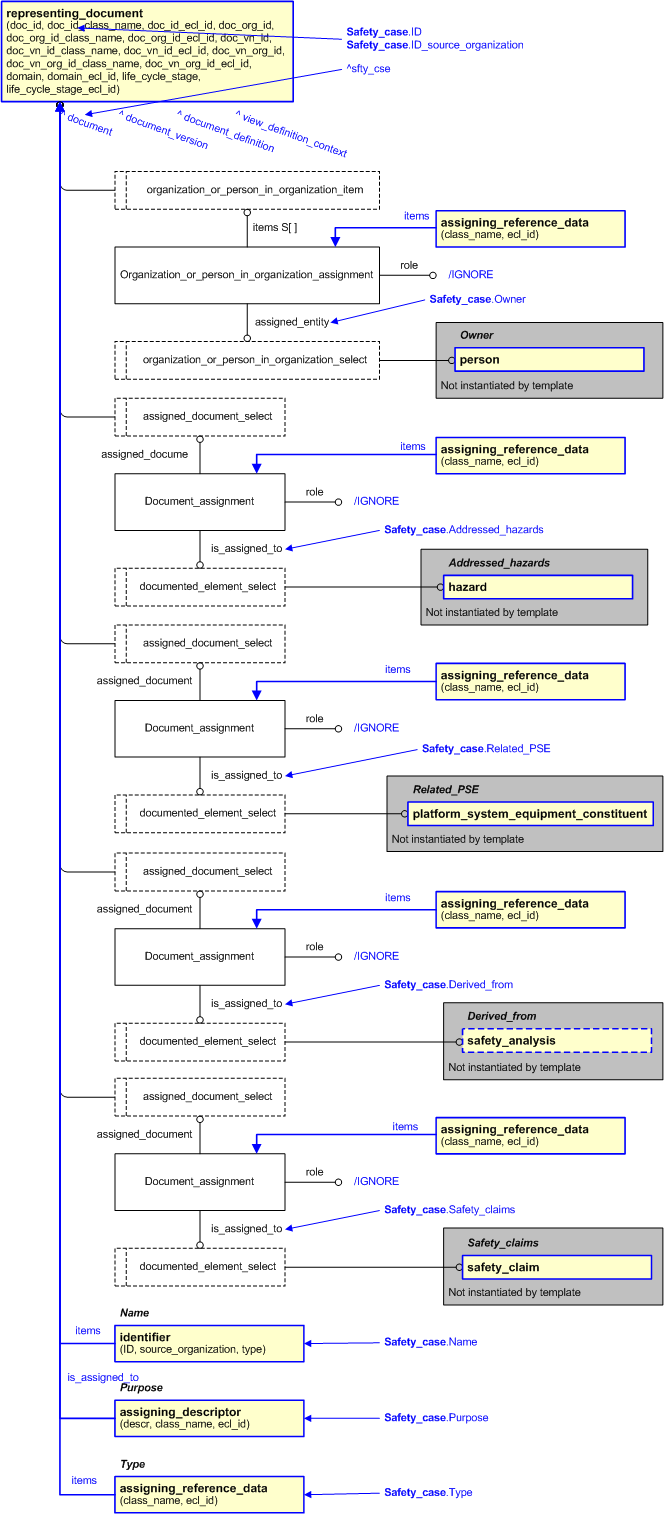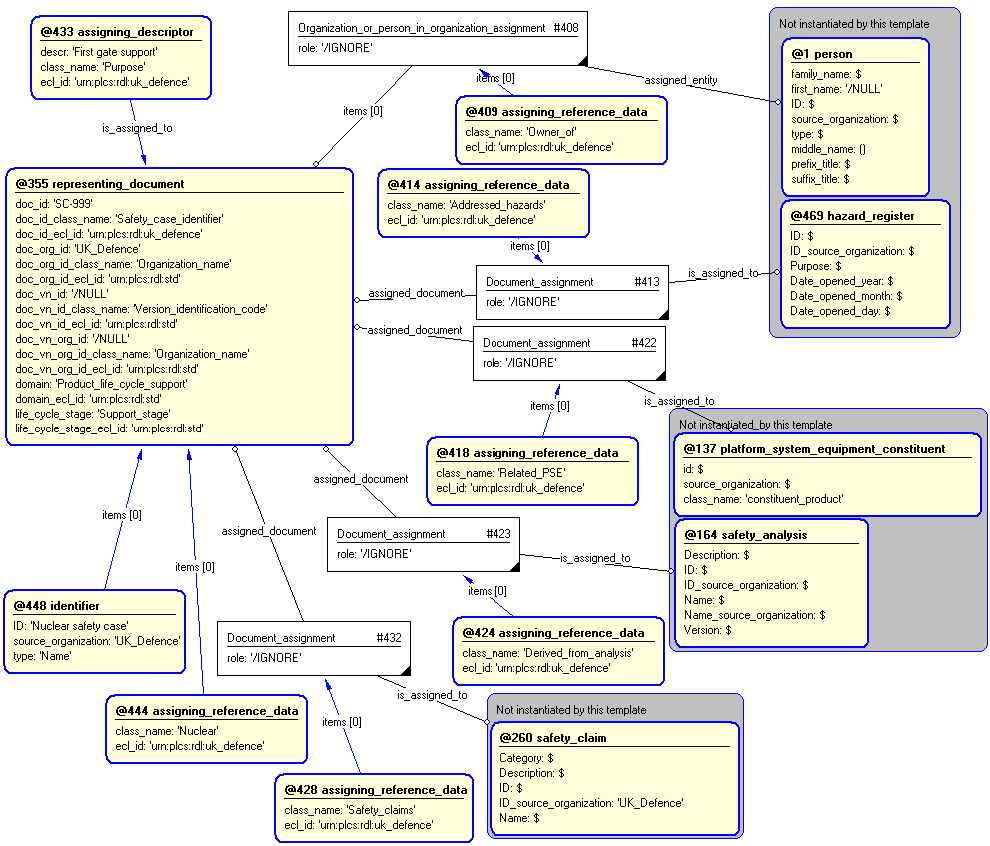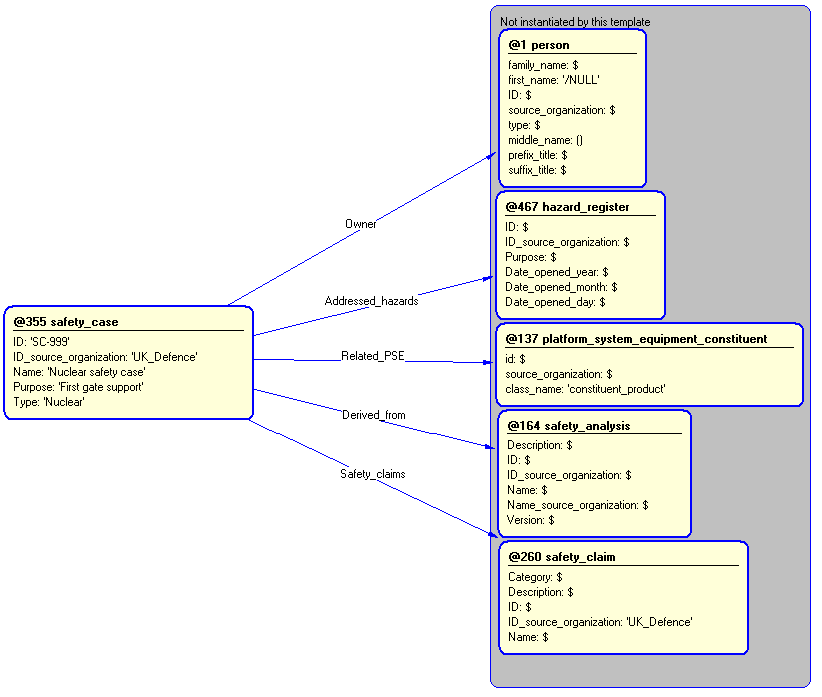Template:— safety_case (sfty_case)
Context:— UK_Defence |
Date: 2010/03/15 15:09:15
Revision: 1.3
|
This section specifies the template safety_case.
NOTE
The template has been defined in the context of
UK_Defence.
Refer to the business context for details of related templates.
NOTE
An explanation of a template and the associated instantiation path is
provided in the
Template overview
section.
This template describes how to represent the concept of safety case in terms of PLCS model elements (templates, entities and
reference data).
A safety case identifies the hazards and safety claims tracked for a specified platform, system and equipment
This information object represents the safety case for the related platform, system and equipment.
Figure 1 — A MOOD Business Architect representation of the Business Object: Safety case
The attributes of the safety case object are tabled below.
|
Attribute name
|
Attribute description
|
Attribute type
|
Optionality
|
| Addressed hazards |
This is the reference to the hazard register against which the safety case has been defined. |
Hazard register |
Mandatory |
| Derived from |
This is the reference to the safety analysis from which the safety case was derived. |
Safety analysis |
Optional |
| ID |
This is the identifier of the safety case. |
intrinsic |
Mandatory |
| Name |
This is the name of the safety case. |
intrinsic |
Mandatory |
| Owner |
This is the reference to the person that owns the safety case. |
Person |
Mandatory |
| Purpose |
This is the purpose of the safety case. |
intrinsic |
Mandatory |
| Related PSE |
This is the reference to the PSE Constituent for which the safety case has been developed. |
Platform System Equipment Constituent |
Mandatory |
| Safety claims |
This is the reference to the set of safety claims that constitute the safety case. |
Safety claim |
Mandatory [1:?] |
| Type |
This is the type of the safety case.
EXAMPLE
Air worthiness,
Nuclear
|
intrinsic |
Mandatory |
Table 1 — Safety case attribute details
The EXPRESS-G diagram in
Figure
2
shows the templates and EXPRESS entities that are required
to represent the template
"safety_case".
The text highlighted in blue shows the template parameters.
Figure 2 — An EXPRESS-G representation of the Information model for safety_case
The graphic for the template to be used in other EXPRESS-G diagrams
is shown in Figure
3
below.
Figure 3 — The graphical representation of the safety_case template
The following input parameters are defined for this template:
This is the reference to the hazard register against which the safety case has been defined.
This is the reference to the safety analysis from which the safety case was derived.
This is the identifier of the safety case.
The organization that created the associated identifier. Additionally
a Person or Information System could be defined when either of these are the source; see Identifier template characterizations
This is the name of the safety case.
This is the reference to the person that owns the safety case.
This is the purpose of the safety case.
This is the reference to the PSE Constituent for which the safety case has been developed.
This is the reference to the set of safety claims that constitute the safety case.
This is the type of the safety case.
The following classes and their sub-classes can be used:
classifications: [Air_worthiness]![[warning:]](../../../../../../images/dex/warning.gif) Error RDL4: The URI urn:plcs:rdl:uk_defence is not listed in dexlib/data/refdata/rdl_index.xml[Nuclear]
Error RDL4: The URI urn:plcs:rdl:uk_defence is not listed in dexlib/data/refdata/rdl_index.xml[Nuclear]![[warning:]](../../../../../../images/dex/warning.gif) Error RDL4: The URI urn:plcs:rdl:uk_defence is not listed in dexlib/data/refdata/rdl_index.xml
Error RDL4: The URI urn:plcs:rdl:uk_defence is not listed in dexlib/data/refdata/rdl_index.xml
The following reference parameters are defined for this template:
Allow the
Document
entity instantiated in this path to be referenced when this template is used.
Note: The
Document
entity can be referenced in a template path by:
%^target = $safety_case.sfty_cse%
where
target
is the parameter to which the
Document
is bound.
The following parameter combinations specify a uniqueness constraint:
Unique constraint: Safety case
Each instance of the
entity
(
Document)
within the data set shall be uniquely identified
by a combination of the following parameters on this
template (safety_case) namely:
Addressed_hazards,
ID,
Related_PSE.
The
instance is
referenced by the following template parameter:
sfty_cse.
The instantiation path shown below specifies the entities that are to be
instantiated by the template.
A description of templates and the syntax for the instantiation path is
provided in the
Templates Help/Information section.
-- Representing document /
representing_document(
doc_id=@ID,
doc_id_class_name='Safety_case_identifier',
doc_id_ecl_id='urn:plcs:rdl:uk_defence',
doc_org_id=@ID_source_organization,
doc_org_id_class_name='Organization_name',
doc_org_id_ecl_id='urn:plcs:rdl:std',
doc_vn_id=/NULL,
doc_vn_id_class_name='Version_identification_code',
doc_vn_id_ecl_id='urn:plcs:rdl:std',
doc_vn_org_id='/NULL',
doc_vn_org_id_class_name='Organization_name',
doc_vn_org_id_ecl_id='urn:plcs:rdl:std',
domain='Product_life_cycle_support',
domain_ecl_id='urn:plcs:rdl:std',
life_cycle_stage='Support_stage',
life_cycle_stage_ecl_id='urn:plcs:rdl:std')/
%^sfty_cse = $representing_document.document%
-- Create relationship to owner Organization_or_person_in_organization_assignmentOrganization_or_person_in_organization_assignment.items ->
^sfty_cse
Organization_or_person_in_organization_assignment.assigned_entity ->
@OwnerOrganization_or_person_in_organization_assignment.role = '/IGNORE'
%^ownr =
Organization_or_person_in_organization_assignment%
/
assigning_reference_data(
class_name='Owner_of',
ecl_id='urn:plcs:rdl:uk_defence',
items=^ownr)/
-- Create relationship to Addressed_hazards Document_assignmentDocument_assignment.role = '/IGNORE'
Document_assignment.assigned_document ->
^sfty_cse
Document_assignment.is_assigned_to ->
@Addressed_hazards%^ah =
Document_assignment%
/
assigning_reference_data(
class_name='Addressed_hazards',
ecl_id='urn:plcs:rdl:uk_defence',
items=^ah)/
-- Create relationship to Related_PSE Document_assignmentDocument_assignment.role = '/IGNORE'
Document_assignment.assigned_document ->
^sfty_cse
Document_assignment.is_assigned_to ->
@Related_PSE%^rpse =
Document_assignment%
/
assigning_reference_data(
class_name='Related_PSE',
ecl_id='urn:plcs:rdl:uk_defence',
items=^rpse)/
-- [Optional Derived_from] Document_assignmentDocument_assignment.role = '/IGNORE'
Document_assignment.assigned_document ->
^sfty_cse
Document_assignment.is_assigned_to ->
@Derived_from%^df =
Document_assignment%
/
assigning_reference_data(
class_name='Derived_from_analysis',
ecl_id='urn:plcs:rdl:uk_defence',
items=^df)/
-- Create relationship to Safety_claims Document_assignmentDocument_assignment.role = '/IGNORE'
Document_assignment.assigned_document ->
^sfty_cse
Document_assignment.is_assigned_to ->
@Safety_claims%^sc =
Document_assignment%
/
assigning_reference_data(
class_name='Safety_claims',
ecl_id='urn:plcs:rdl:uk_defence',
items=^sc)/
-- Name /
identifier(
ID=@Name,
source_organization=@ID_source_organization,
type='Name',
items=^sfty_cse)/
-- Purpose /
assigning_descriptor(
descr=@Purpose,
class_name='Purpose',
ecl_id='urn:plcs:rdl:uk_defence',
is_assigned_to=^sfty_cse)/
-- Type /
assigning_reference_data(
class_name=@Type,
ecl_id='urn:plcs:rdl:uk_defence',
items=^sfty_cse)/
The following entities are instantiated with attributes as specified:
The instance diagram in Figure
4
shows an example of the EXPRESS entities and templates that are instantiated by the template:
/safety_case(Addressed_hazards='#ah', Derived_from='#df', ID='SC-999', ID_source_organization='UK_Defence', Name='Nuclear safety case', Owner='#o', Purpose='First gate support', Related_PSE='#p', Safety_claims='#sc', Type='Nuclear')/
(an illustration of the consolidated safety_case template is shown in
Figure
5 below.)
Figure 4 — Entities instantiated by safety_case template
The instance diagram in
Figure
5
shows the graphic symbol for the template that is to be
used in other instance diagrams. The example template is:
/safety_case(Addressed_hazards='#ah', Derived_from='#df', ID='SC-999', ID_source_organization='UK_Defence', Name='Nuclear safety case', Owner='#o', Purpose='First gate support', Related_PSE='#p', Safety_claims='#sc', Type='Nuclear')/
Figure 5 — Instantiation of safety_case template
Characterizations
No common characterizations of the template
safety_case
have been identified. However, the ISO 10303-239 EXPRESS model
may enable other assignments to the entities instantiated by the template.




